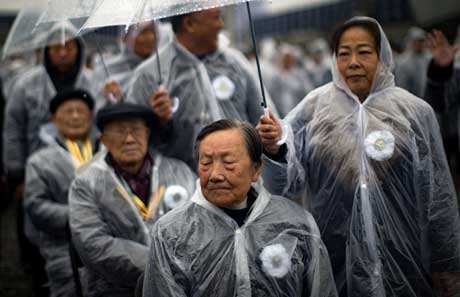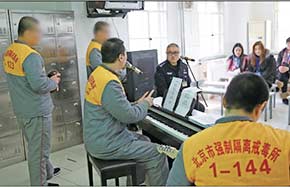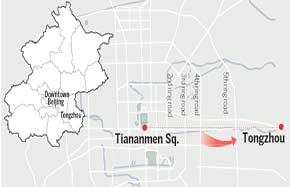China issues white paper on right to development
III. Effectively Realizing Economic Development
China always considers economic development as the central task, laying a solid foundation for safeguarding the right to development. At the same time economic development is strengthened by safeguarding the people's right to development. Since the reform and opening-up policy was launched in 1978, China has witnessed rapid economic growth, and has become the world's second largest economy. There have been two historic leaps in living standards, from living in poverty to having access to basic material needs, and then to moderate prosperity.
The right to subsistence of the poor is effectively guaranteed. The poverty reduction campaign in China is the most significant sign of China's progress in human rights. Since the end of 1978, China has realized "the most rapid large-scale poverty reduction in human history over the last 25 years."[Note: "Reducing Poverty on a Global Scale: Learning and Innovating for Development Findings from the Shanghai Global Learning Initiative," a World Bank document on Nov. 14, 2016.] According to the existing rural poverty standards, it has reduced the number of those living in poverty by more than 700 million, which is more than the total population of the United States, Russia, Japan and Germany, and cut the rate of poverty to 5.7 percent, becoming the first country to complete the United Nations Millennium Development Goals. By the end of 2015, the number of rural people living in poverty had fallen to 55.75 million. In the five autonomous regions of Inner Mongolia, Guangxi, Tibet, Ningxia and Xinjiang, and in the provinces of Guizhou, Yunnan, and Qinghai, where ethnic minorities are concentrated, the number of rural people living in poverty had fallen to 18.13 million. China's poverty reduction campaign has effectively contributed to granting its disadvantaged people the right to development, laying a solid foundation for the building of a moderately prosperous society in all respects. In November 2015, the CPC Central Committee and the State Council issued the "Decision on Winning the Tough Battle Against Poverty," making comprehensive arrangements for poverty eradication work in the following five years. In March 2016, the "Outline of the 13th Five-Year Program for the National Economic and Social Development of the People's Republic of China" was published, in which the Chinese government made strategic plans for the full implementation of the overall goal of poverty eradication. In order to realize the ambitious goal of relieving the rural poor population of poverty by 2020, China is carrying out a basic strategy of targeted poverty alleviation and targeted poverty eradication.
The right to work is fully realized. Economic development creates more jobs. Urban and rural employment continued to increase from 761 million in 2010 to 775 million in 2015. Within these figures, urban employment increased from 347 million to 404 million, representing an average annual increase of more than 11 million. In 2015 urban employment increased by 13.12 million, and the registered urban unemployment rate by the end of the year was 4.05 percent, showing steady progress in this work. From 2008 to 2015, the central government assigned a total of RMB305.51 billion as subsidies to be used in employment. Since 2009, the Chinese government has implemented a policy of financial discount for small-sum guaranteed loans to women. By June 2016, a total of RMB279.4 billion in loans had been provided to 5.38 million women, supporting more than 10 million, including women classified as poor, to start their own businesses or find work. The number of women in employment has increased continuously and their positions have improved. In 2014, employed women accounted for 45 percent of the total workforce in China, and female professional and technical personnel accounted for 46.5 percent of the national total. The government strengthens skill training to promote more equitable sharing of job opportunities through capacity-building. By the end of 2015, the total number of skilled workers in the country had reached 167 million, of whom 45.01 million were highly skilled. The government actively promotes transfer of the rural labor force to employment in local or nearby places, ensuring that 65 percent can find employment within the local county economy. The government vigorously develops the service industry, creating jobs for rural migrant workers, and setting up farmers' markets and food stalls with reduced or zero fees. As a result, more than 80 percent of rural migrant workers have found jobs in small and micro businesses. The government also encourages rural migrant workers to return home and start businesses. By the end of 2015, 4.5 million rural migrant workers had returned home to start businesses, and rural small and micro businesses amounted to 6.99 million. By the end of 2014, China had 15.46 million private enterprises, and nearly 50 million self-employed businesses, representing increases of 83 percent and 44 percent over 2010; these businesses employed 250 million people. Internet entrepreneurship has helped nearly 10 million people find employment, and "Internet+" is an important channel for creating jobs. The government takes measures to guide graduates to find employment through multiple channels, encourage entrepreneurship, and offer better employment services to graduates and give more assistance to those experiencing difficulties in finding jobs. In recent years, the employment rate of new college graduates has been above 70 percent every year, and the overall employment rate at the end of the year has exceeded 90 percent. By aiding enterprises, and offering employment support and assistance, the government helps unemployed persons and people having difficulty in securing jobs to find employment, and devotes particular attention to zero-employment families. From 2011 to 2015, more than 5.5 million unemployed urban people found jobs every year, while an annual average of almost 1.8 million people having difficulty in securing jobs found employment. Steady progress has been made in the employment of people with disabilities. During the 12th Five-Year Program period (2011-2015), the government helped 1.52 million urban residents with disabilities to find jobs. In 2015, 21,596,300 disabled people of working age across the country found jobs. The people's basic living standards have greatly improved. In 1978, the Engel coefficient of urban households was 57.5 percent and that of rural households was 67.7 percent; in 2015, the figures dropped to 29.7 percent and 33.0 percent respectively. From 1978 to 2015, urban residents saw an increase in their residential area from 6.7 square meters per capita to more than 33 square meters; the corresponding figures for rural residents were 8.1 square meters to more than 37 square meters. A housing security system with government-supported low-rent housing and economically affordable housing as the main forms is in place. In 2015, the national investment in residential buildings reached RMB8,024.77 billion. Within this program, 7.72 million units of government-subsidized urban housing were completed, and construction on another 7.83 million units already started. The central government provided RMB36.5 billion to subsidize the renovation of sub-standard houses for 4.32 million poor rural households around China. From 2011 to 2015, under the government-subsidized urban housing project, China built a total of 40.13 million new units, renovated 21.91 million households in shantytowns, and moved a large number of people with housing difficulties into apartments, realizing "livable" residences. From 2011 to 2015, public finance at all levels subsidized barrier-free reconstruction for 675,000 families with disabled members, improving their quality of life.
Travel conditions have greatly improved. From 1978 to 2015, highways in service rose from 890,000 km to 4.58 million km, and the civil aviation passenger throughput grew from 2.32 million to 915 million. In 2015, the total mileage of expressways open to traffic in China reached 123,500 km, the operating mileage of high-speed railways reached 19,000 km. 94.5 percent of villages had paved road access, and 94.3 percent of villages had access to bus services.
The people's living standards have significantly improved. From 1978 to 2015, the annual GDP increased from RMB367.9 billion to RMB68,550.6 billion, and per capita GDP grew from more than US$200 to above US$8,000. In 1978, per capita disposable income of urban households was only RMB343.4, and per capita net income of rural households was only RMB133.6. In 2015, per capita disposable income of all residents reached RMB21,966; the figures were RMB31,195 for urban residents and RMB11,422 for rural residents. By the end of 2015, the total number of phone users nationwide reached 1,536.73 million, and 1,305.74 million of them were mobile phone users, with a penetration rate of 95.5 per 100 people. There were 213.37 million households with fixed broadband Internet access, and 785.33 million mobile broadband users. The number of Internet users was 688 million, and the household penetration rate of fixed broadband reached 50.3 percent. In 2015, Chinese residents made 127.86 million outbound trips, including 121.72 million private trips. Civilian car ownership was 95.08 million, of which 87.93 million were private cars.


























